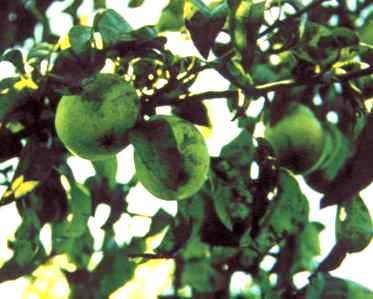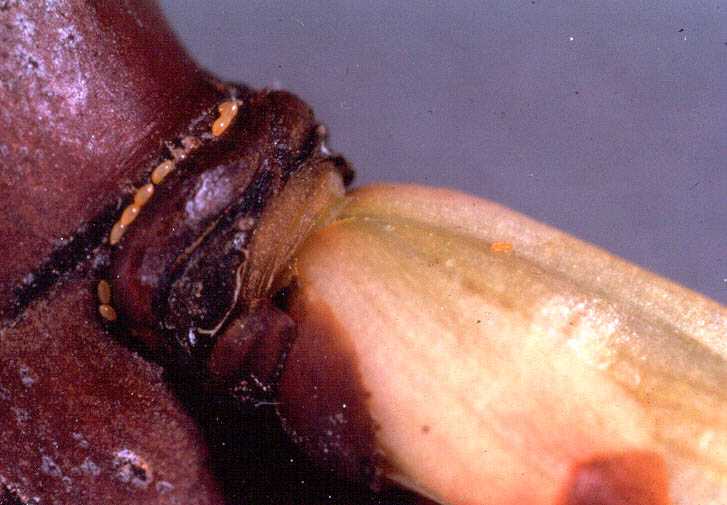Pear Psylla
General Description
Hosts
Pear.
Damage
Presence of honeydew and black sooty mold on fruit (Fig. 1), leaves and bark, and brownish-black patches of dead tissue on leaves indicates pear psylla infestations (Fig. 2). Sooty mold grows on the honeydew secreted by psylla nymphs. Heavy infestations can cause premature leaf drop, weaken fruit buds and reduce shoot growth. Honeydew causes enlargement and blackening of pores on the skin of the fruit and, along with the presence of sooty mold, results in downgrading of fruit.
 |
.jpg) |
| Figure 1. Pear psylla damage to pear. (BCMA) | Figure 2. Pear psylla damage to pear fruit. (BCMA) |
Identification
Eggs - Oval, about 0.5 mm long; white when laid, gradually turning yellow (Fig. 3).
 |
| Figure 3. Pear psylla eggs. (AA-FC) |
Nymphs - Five growth stages, the first three are yellow with red eyes and live within droplets of honeydew. Stage 4 is green with small wing pads and lives freely without honeydew droplets. The fifth stage (hard-shell) is brown to black with distinct wing pads (Fig. 4).
.jpg) |
| Figure 4. Pear psylla adults and 'hard-shell' nymph. (AA-FC) |
Adults - Summer adults are greenish to brown in colour with pale wings held roof-like over the 3 mm-long body (Fig. 4). Overwintering adults are larger and darker in colour.
Life History
Pear psylla overwinter as adults on trees and shrubs adjacent to pear orchards to which they return in early March to begin laying eggs on or near buds. In the summer, females lay eggs along the mid vein of leaves on new shoots and suckers, or on lower leaves when populations are very high. There are three or four overlapping generations each year; overwintering adults appear in late summer.
Monitoring
In the dormant period, use a limb tap sample of 25 limb taps/hectare of orchard. If a dormant treatment is applied, sample again 10 to14 days later to determine the need for a second dormant or a pink treatment. In June collect 100 spur leaves and examine for eggs and nymphs. Repeat the procedure in July and August by collecting 100 terminal leaves for examination. Psylla predators (see Biological Control below) should also be monitored using limb taps at 3-4 week intervals.
Management
Biological Control
Many predatory insects such as the mullein bug (campylomma), pirate bugs (anthocorids), lacewings, ladybird beetles, earwigs and some species of ants, feed upon pear psylla. Preservation of these beneficial insects by avoiding use of certain chemicals has proven to be effective in reducing psylla numbers. Refer to the table Relative Toxicity Rating of Insecticides/Miticides to Common Beneficial Insects and Mites to aid in selecting the least disruptive products.
Cultural Control
Reduce excessive tree vigour by limiting nitrogen applications and summer pruning to reduce psylla numbers.
Chemical Control
Dormant to Pink Bud Stage - Apply a dormant or pink spray if one or more psylla adults are collected per limb tap in the spring. Dormant oil sprays applied in early March will discourage psylla from laying eggs on pear trees for about 6 weeks until leaves emerge. The addition of lime-sulfur to this early dormant oil treatment will improve control of adult psylla and also suppress pear rust mite and pearleaf blister mite. If the average number of psylla per limb tap remains at or above one, apply a second half-rate of oil.
Summer- For summer control of pear psylla, apply Agri-Mek SC with oil, Assail, insecticidal soap, Nexter or Movento 240 SC. Do not exceed 1500 mL Agri-Mek per ha per season. Agri-Mek plus oil may cause fruit injury to d’Anjou when temperatures exceed 30°C within 24 hours of application. Application of Agri-Mek will also control twospotted spider mite, European red mite, and pear rust mite. Use Agri-Mek in rotation with products with different modes of action to avoid development of pesticide resistance.
Assail has short residual activity against adult psylla (2-3 days), however the chemical is absorbed into the leaves where it will provide up to 7 days protection at label rates (67-240 g/ha). Do not apply more than 2 times per season. This product will also control any codling moth larvae present at the time of application. Lower rates have less impact on beneficial insects and allow quicker rebound after application.
An alternative to Agri-Mek is insecticidal soap. Soap sprays are very effective against nymphs, partially effective against adults and not effective against eggs. Spray volumes of 2000 L/ha or more must be used for soap sprays to be effective. Apply the first sprays when newly hatched nymphs appear on new growth. Repeat treatments at 10-14 day intervals as long as the nymphs are present so that they don’t develop to the hard-shell stage.
Apply Movento in combination with a recommended non-ionic adjuvant (e.g. Agral 90) after petal fall. Movento should be applied when sufficient leaf tissue is present to allow for maximum uptake of the active ingredient by the plant. Movento is slow-acting so allow 12 – 18 days for noticeable decline in populations.
Pesticide resistance management – Psylla can develop resistance to successively applied insecticides from the same chemical class or with the same mode of action. Always select products with different Group numbers to alternate in a rotational program to prevent or minimize the risk of pesticide resistance.
Integrated Control Program
The integrated control of pear psylla involves the combined use of cultural and biological control methods (see above) with the careful selection and application of chemical control products for psylla and other pests. It is important to monitor psylla and beneficials as well as to keep accurate records of monitoring results and spray treatments (see Grower’s Forms) for the program to be most successful.
Products recommended for psylla control are as listed above under Chemical Control. For other pests, apply only products that do not harm psylla predators. For leafrollers and bud moth, an effective spring control program is essential to minimize the need for summer control sprays (see discussion for leafroller control). Apply a Bacillus thuringiensis (Bt) product (Dipel, Foray or Bioprotec), Confirm, Success/Entrust, Delegate, Exirel or Altacor when larvae are actively feeding in the spring. These products will also control any fruitworm present. Ensure thorough coverage because leafroller larvae must eat these products to be most effective. Do not apply Confirm for control of leafroller populations tolerant to organophosphate products. Success can harm earwigs and parasitic wasps exposed to direct sprays but the threat is reduced once the residues dry.
For codling moth, use Altacor, Assail, Calypso, Delegate, Exirel or TwinGuard if and when the treatment threshold is reached to supplement the release of sterile moths (see Codling Moth description). Mating disruption products Isomate-C Plus or Isomate CM Flex (codling moth only) or Isomate-CM/LRTT (codling moth and leafrollers) is another supplemental control option.
Treat orchards requiring control of San Jose scale with dormant oil prebloom.
For control of European red mite and McDaniel spider mite during the summer, use Apollo, Envidor, Kanemite or Nexter. Apollo is harmless to predatory mites. Use Kumulus or Cosavet DF for control of pear rust mite.
